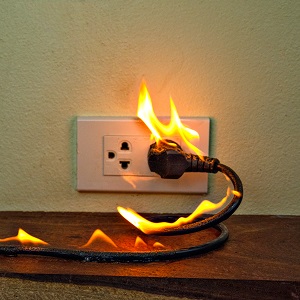HOW TO PREVENT ELECTRICAL FIRES
HOW TO PREVENT ELECTRICAL FIRES
Electricity certainly makes our lives easier, but do not take electricity’s power and its potential for fire-related hazards for granted. According to the NFPA*, electrical and lighting fires make up roughly 10% of all reported fires. These electrical fires cause an average of 470 deaths and 1100 civilian injuries per year. Electrical fires rank first in property damage of reported fires, third among major home fire causes, fourth in home fire deaths and ties for third in home fire injuries.
HOW TO PREVENT ELECTRICAL FIRES – INDOORS
The National Fire Protection Agency (NFPA) and the Electrical Safety Foundation International (ESFI) both recommend that all electrical work be done by qualified electricians for doing any repairs, building or remodeling of your home.
Only use one heat-producing appliance (such as a coffee maker, toaster, space heater, etc.) plugged into a receptacle outlet at a time. Any major appliances (refrigerators, dryers, washers, stoves, air conditioners, microwave ovens, etc.) should be plugged directly into a wall receptacle outlet. Extension cords and plug strips should not be used.
Arc-fault circuit interrupters (AFCIs) shut off electricity when a dangerous condition occurs. Consider having them installed in your home. Also use ground-fault circuit interrupters (GFCIs) to reduce the risk of shock. GFCIs shut off an electrical circuit when it becomes a shock hazard. They should be installed inside the home in bathrooms, kitchens, garages and basements. All outdoor receptacles should be GFCI protected. Test all AFCIs and GFCIs once a month according to the manufacturer’s recommendations.
You do not need a flame to start a fire. Fires can start when heat builds up near things that burn. This can happen when a hot light bulb is near things that burn, such as cloth or paper, or a cord has been placed under a carpet. Make sure that electrical cords are not running across doorways or under carpets.
Remember that extension cords are intended for temporary use. For long-term electrical needs, have a qualified electrician add more receptacle outlets so you don’t have to use extension cords.
Make sure that all light bulbs being used are the right number of watts. There should be a sticker that indicates the right number of watts.
HOW TO PREVENT ELECTRICAL FIRES – OUTDOORS
Use only lighting and power tools that are listed by a qualified test laboratory and are specifically for outside use. Store all electrical tools indoors and keep away from children.
Always check lighting and extension cords for damage before use. Replace any damaged cords immediately. Only use extension cords that are listed by a qualified test laboratory and are specifically for outside use. Only use outdoor extension cords for temporary purposes.
Have professional tree cutting services to trim any branches that may fall or touch electrical wiring. Power lines may be live, so stay a safe distance from them. Never touch anyone or anything that is in contact with a downed wire.
Only use either wooden or fiberglass ladders outdoors and keep them at least 10 feet away from any power lines.
*Get additional information at www.nfpa.org
